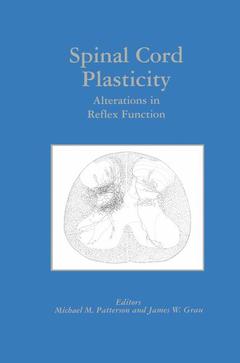Description
Spinal Cord Plasticity, 2001
Alterations in Reflex Function
Coordinators: Patterson Michael M., Grau James W.
Language: English
Subject for Spinal Cord Plasticity:
Keywords
brain; neurons; physiology; psychology; rehabilitation; spinal cord
Spinal Cord Plasticity
Publication date: 10-2012
243 p. · 15.5x23.5 cm · Paperback
Publication date: 10-2012
243 p. · 15.5x23.5 cm · Paperback
Spinal cord plasticity
Publication date: 07-2001
243 p. · 15.5x23.5 cm · Paperback
Publication date: 07-2001
243 p. · 15.5x23.5 cm · Paperback
Description
/li>Contents
/li>
The area of spinal cord plasticity has become a very actively researched field. The spinal cord has long been known to organize reflex patterns and serve as the major transmission pathway for sensory and motor nerve impulses. However, the role of the spinal cord in information processing and in experience driven alterations is generally not recognized. With recent advances in neural recording techniques, behavioral technologies and neural tracing and imaging methods has come the ability to better assess the role of the spinal cord in behavioral control and alteration. The discoveries in recent years have been revolutionary. Alterations due to nociceptive inputs, simple learning paradigms and repetitive inputs have now been documented and their mechanisms are being elucidated. These findings have important clinical implications. The development of pathological pain after a spinal cord injury likely depends on the sensitization of neurons within the spinal cord. The capacity of the spinal cord to change as a function of experience, and adapt to new environmental relations, also affects the recovery locomotive function after a spinal cord injury. Mechanisms within the spinal cord can support stepping and the capacity for this behavior depends on behavioral training. By taking advantage of the plasticity inherent within the spinal cord, rehabilitative procedures may foster the recovery of function.
Foreword. 1. Spinal Plasticity; R.F. Thompson. 2. Pavlovian and Instrumental Conditioning Within the Spinal Cord: Methodological Issues; J. W. Grau, R.L. Joynes. 3. Pavlovian Conditioning of Flexion Reflex Potentiation in Spinal Cat: Temporal Effects Following Spinal Transection; R.G. Durkovic. 4. Spinal Fixation: Long-term Alterations in Spinal Reflex Excitability With Altered or Sustained Sensory Inputs; M.M. Patterson. 5. Spinal Cord Plasticity in the Acquisition of a Simple Motor Skill; J.R. Wolpaw. 6. Mechanisms of Central Sensitization of Nociceptive Dorsal Horn Neurons; W.D. Willis, Jr. 7. Noxious Stimulus-Induced Plasticity in Spinal Cord Dorsal Horn: Evidence and Insights on Mechanisms Obtained Using the Formalin Test; T.J. Coderre. 8. Neural Darwinism in the Mammalian Spinal Cord; V. Reggie Edgerton, et al. 9. Spinal Cord Plasticity Associated with Locomotor Compensation to Peripheral Nerve Lesions in the Cat; L. Bouyer, S. Rossignol. 10. Laufband (Treadmill) Therapy in Incomplete Para- and Tetraplegia; A. Wernig, et al. Index
© 2024 LAVOISIER S.A.S.




